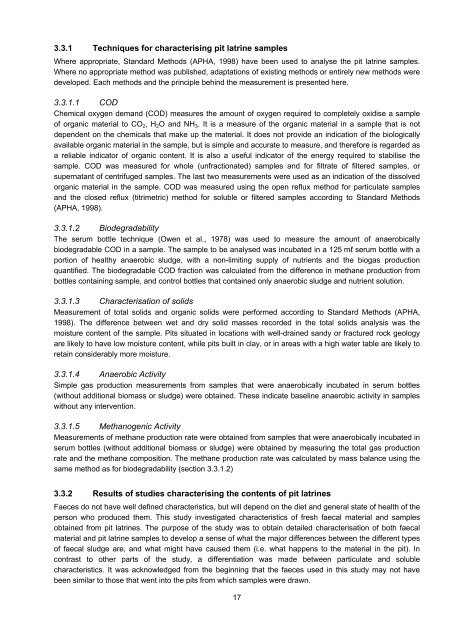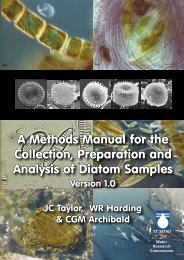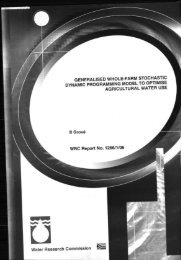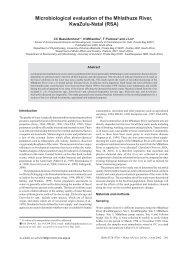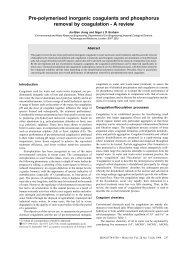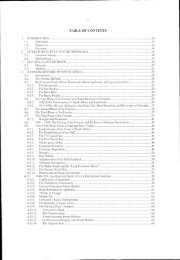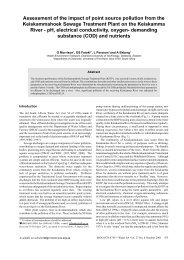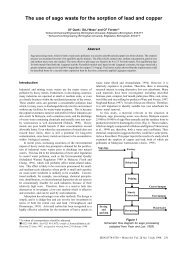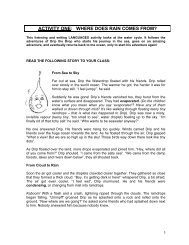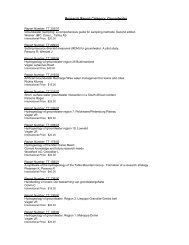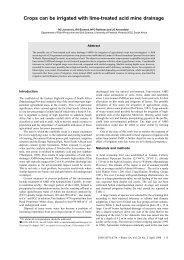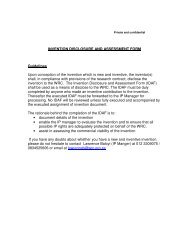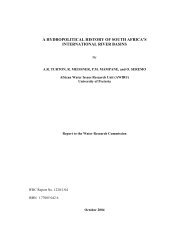and the Efficacy of Pit Latrine Additives - Water Research Commission
and the Efficacy of Pit Latrine Additives - Water Research Commission
and the Efficacy of Pit Latrine Additives - Water Research Commission
- No tags were found...
You also want an ePaper? Increase the reach of your titles
YUMPU automatically turns print PDFs into web optimized ePapers that Google loves.
3.3.1 Techniques for characterising pit latrine samples<br />
Where appropriate, St<strong>and</strong>ard Methods (APHA, 1998) have been used to analyse <strong>the</strong> pit latrine samples.<br />
Where no appropriate method was published, adaptations <strong>of</strong> existing methods or entirely new methods were<br />
developed. Each methods <strong>and</strong> <strong>the</strong> principle behind <strong>the</strong> measurement is presented here.<br />
3.3.1.1 COD<br />
Chemical oxygen dem<strong>and</strong> (COD) measures <strong>the</strong> amount <strong>of</strong> oxygen required to completely oxidise a sample<br />
<strong>of</strong> organic material to CO 2 , H 2 O <strong>and</strong> NH 3 . It is a measure <strong>of</strong> <strong>the</strong> organic material in a sample that is not<br />
dependent on <strong>the</strong> chemicals that make up <strong>the</strong> material. It does not provide an indication <strong>of</strong> <strong>the</strong> biologically<br />
available organic material in <strong>the</strong> sample, but is simple <strong>and</strong> accurate to measure, <strong>and</strong> <strong>the</strong>refore is regarded as<br />
a reliable indicator <strong>of</strong> organic content. It is also a useful indicator <strong>of</strong> <strong>the</strong> energy required to stabilise <strong>the</strong><br />
sample. COD was measured for whole (unfractionated) samples <strong>and</strong> for filtrate <strong>of</strong> filtered samples, or<br />
supernatant <strong>of</strong> centrifuged samples. The last two measurements were used as an indication <strong>of</strong> <strong>the</strong> dissolved<br />
organic material in <strong>the</strong> sample. COD was measured using <strong>the</strong> open reflux method for particulate samples<br />
<strong>and</strong> <strong>the</strong> closed reflux (titrimetric) method for soluble or filtered samples according to St<strong>and</strong>ard Methods<br />
(APHA, 1998).<br />
3.3.1.2 Biodegradability<br />
The serum bottle technique (Owen et al., 1978) was used to measure <strong>the</strong> amount <strong>of</strong> anaerobically<br />
biodegradable COD in a sample. The sample to be analysed was incubated in a 125 ml serum bottle with a<br />
portion <strong>of</strong> healthy anaerobic sludge, with a non-limiting supply <strong>of</strong> nutrients <strong>and</strong> <strong>the</strong> biogas production<br />
quantified. The biodegradable COD fraction was calculated from <strong>the</strong> difference in methane production from<br />
bottles containing sample, <strong>and</strong> control bottles that contained only anaerobic sludge <strong>and</strong> nutrient solution.<br />
3.3.1.3 Characterisation <strong>of</strong> solids<br />
Measurement <strong>of</strong> total solids <strong>and</strong> organic solids were performed according to St<strong>and</strong>ard Methods (APHA,<br />
1998). The difference between wet <strong>and</strong> dry solid masses recorded in <strong>the</strong> total solids analysis was <strong>the</strong><br />
moisture content <strong>of</strong> <strong>the</strong> sample. <strong>Pit</strong>s situated in locations with well-drained s<strong>and</strong>y or fractured rock geology<br />
are likely to have low moisture content, while pits built in clay, or in areas with a high water table are likely to<br />
retain considerably more moisture.<br />
3.3.1.4 Anaerobic Activity<br />
Simple gas production measurements from samples that were anaerobically incubated in serum bottles<br />
(without additional biomass or sludge) were obtained. These indicate baseline anaerobic activity in samples<br />
without any intervention.<br />
3.3.1.5 Methanogenic Activity<br />
Measurements <strong>of</strong> methane production rate were obtained from samples that were anaerobically incubated in<br />
serum bottles (without additional biomass or sludge) were obtained by measuring <strong>the</strong> total gas production<br />
rate <strong>and</strong> <strong>the</strong> methane composition. The methane production rate was calculated by mass balance using <strong>the</strong><br />
same method as for biodegradability (section 3.3.1.2)<br />
3.3.2 Results <strong>of</strong> studies characterising <strong>the</strong> contents <strong>of</strong> pit latrines<br />
Faeces do not have well defined characteristics, but will depend on <strong>the</strong> diet <strong>and</strong> general state <strong>of</strong> health <strong>of</strong> <strong>the</strong><br />
person who produced <strong>the</strong>m. This study investigated characteristics <strong>of</strong> fresh faecal material <strong>and</strong> samples<br />
obtained from pit latrines. The purpose <strong>of</strong> <strong>the</strong> study was to obtain detailed characterisation <strong>of</strong> both faecal<br />
material <strong>and</strong> pit latrine samples to develop a sense <strong>of</strong> what <strong>the</strong> major differences between <strong>the</strong> different types<br />
<strong>of</strong> faecal sludge are, <strong>and</strong> what might have caused <strong>the</strong>m (i.e. what happens to <strong>the</strong> material in <strong>the</strong> pit). In<br />
contrast to o<strong>the</strong>r parts <strong>of</strong> <strong>the</strong> study, a differentiation was made between particulate <strong>and</strong> soluble<br />
characteristics. It was acknowledged from <strong>the</strong> beginning that <strong>the</strong> faeces used in this study may not have<br />
been similar to those that went into <strong>the</strong> pits from which samples were drawn.<br />
17


